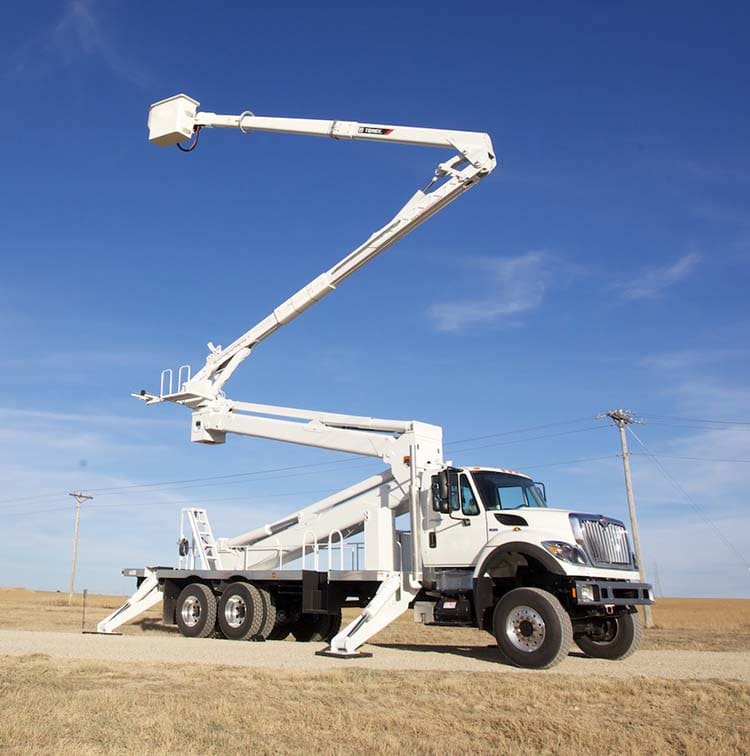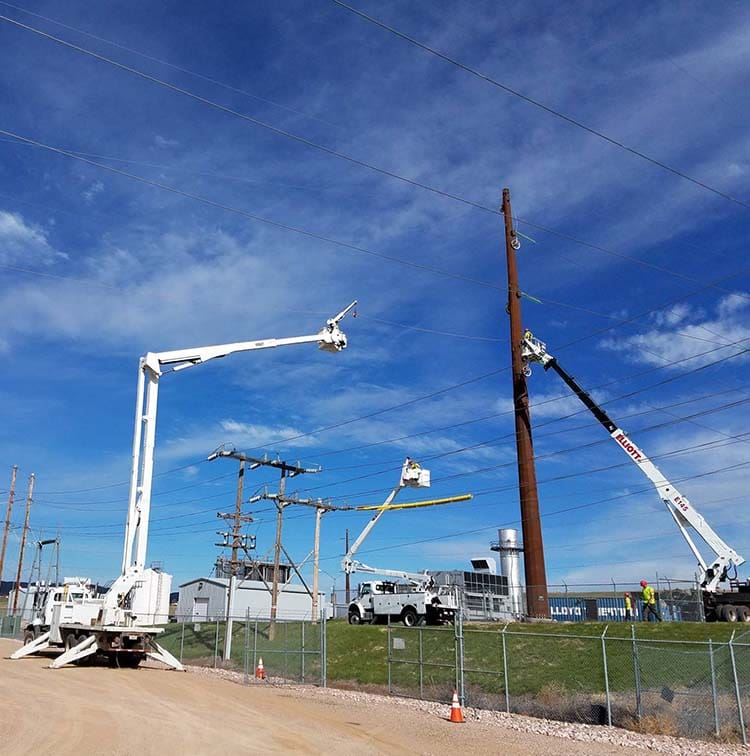

Any job that requires workmen to repair, remove, or install something high off the ground may require the services of a bucket truck.
At its core, a bucket truck is simply a utility truck fitted with a hydraulic pole (boom) that has a man-carrying bucket at its end. The bucket helps keeps the worker safe as the boom lifts him up to where he can comfortably use his tools and safely perform his job.
Having long been used to perform traditional aerial tasks in sectors such as telecommunication, utility, signage, forestry, and construction, bucket trucks are becoming even more commonplace. This is due to more stringent OSHA regulations mandating a decrease in use of ladders and scaffoldings to perform various off-the-ground jobs that may be unsafe and lead to accidents.
Market intelligence studies predict the global bucket truck market will scale up to a valuation of $ 1.5 billion by 2027. With increasing demands from all over the world as end-user companies increase their spend on smart infrastructure solutions, bucket truck OEMs (such as Terex Corporation, Versalift, and Altec) are also raising the bar on the attributes of their units. This results in more efficient fuel-conserving innovations and improved safety, aerodynamics, and operational technology.


The History of Bucket Trucks
Not so long ago, when bucket trucks first came to market in the 1900s, they were commonly known as `cherry-pickers’ because of the popularity of their use in the fruit-picking industry.
Compensation claims by orchard workers have been historically high, compared to other type of agricultural workers, with a majority of accidents occurring due to falls from ladders. Aerial work platform (AWP) devices, like mechanically lifted buckets, not only reduced the chance of accidents exponentially, they also increased efficiency. Therefore, it was only a matter of time before other industries –such as mining, utilities, forestry, and construction – found bucket trucks to be indispensable in their line of work as well.
Over the decades since, the design of these early bucket trucks has improved, and continues to improve to this day. They are now being custom engineered for specialized jobs, offering better functionalities, ease of use, fuel conservation, and, of course, safety.
Types of Bucket Trucks
Telescopic Bucket Trucks
Telescopic bucket trucks are often referred to as “squirt booms” or “stick booms” in the heavy equipment industry. Unlike the articulated version, the straight booms on these trucks have no knuckles and therefore can only extend telescopically. The biggest advantage of telescopic bucket trucks is the greater horizontal reach they afford, compared to any other boom. This is a very useful attribute when working in limited access areas.
Telescoping Bucket Trucks include the Elliott H110F and the Elliott E-Line Series (i.e. Elliott E160).
Articulating Telescopic Bucket Trucks
Articulated/Telescopic Bucket Trucks are also known as “knuckle/squirt booms” because of their unique ability to unfold like the traditional knuckle booms with an added telescopic feature. This allows for increased side reach at higher elevations, while reducing tail swing on the opposite side of where the work is being performed. In many cases, this particular design limits the number of times a your bucket truck will have to be repositioned, which increases productivity.
The Terex LT40 and the Versalift VST-7500-E108 are examples of articulating bucket trucks.
Overcenter Bucket Trucks
Within the articulating category, you’ll find overcenter bucket trucks. Overcenter booms will allow the bucket to move beyond the center of the truck, extending the side reach, which can be very useful for forestry, utility, and construction jobs.
Check out the Terex HRX55 Overcenter Bucket Truck.
Non-Overcenter Bucket Trucks
Non-overcenter bucket trucks cannot move the bucket beyond the center of the truck and therefore are more restricted in their reach. However, often that that isn’t necessary, especially when your primary focus is working height.
Check out Custom Truck’s selection of Non-Overcenter Bucket Trucks such as the Terex TC55 or the Terex TM125.
Insulated Bucket Trucks
Insulated bucket trucks are mainly used by utility crews and those working around electrical cabling, because they help safeguard against accidental electrocution. Two components of these trucks are constructed of dielectric materials, like fiberglass, to prevent conduction of electricity: the boom and the bucket.
Non-Insulated Bucket Trucks
As the name suggests, non-insulated booms do not have a fiberglass coating on their booms and buckets, which means they don't help protect from electrocution. These are used in applications where there is no need for this safety feature. Instead, they are simply made of steel.
The Posi-Plus 800 and the Versalift SST-36-NE are examples of non-insulated bucket trucks.
Material Handler Bucket Trucks
Along with lifting workmen, these trucks are designed to also lift a moderate load of material without additional equipment or special rigging. In other words, these do two jobs with one piece of equipment.
Track Bucket Trucks
Several factors, such as traction, ground pressure, suspension, and steering, make track bucket trucks an alternative in situations with rough, uneven, or swampy terrains. Traction, for example, is greater when the equipment moves on tracks instead wheels and exerts less ground pressure.
Check out Custom Truck’s selection of Track Bucket Trucks.

As the name suggests, material handling bucket trucks focus on the material handling features that distinguish this type of truck from other bucket trucks. Modified versions of the traditional bucket trucks, material handling bucket trucks are designed specifically to handle moderate sized loads in addition to supporting personnel in buckets. The purpose of a material handling bucket truck is the quick, safe and easy movement of materials as compared to doing it manually.

The first thing to remember when buying a bucket truck is this: they’re available in a many variations and combinations. In other words, the customization options to suit your specific application are plentiful.
That said, there are at least 6 things to consider when buying a new or used bucket truck:
This refers to the highest level at which a worker can safely perform his job from a bucket, with the truck in a stabilized condition. Typically, bucket trucks have three height tiers: less than 50 feet, 50-59 feet, and over 60 feet. Pay for only as much height as you expect to need. There is no point buying a truck with a 60-ft working height when the maximum you’ll ever need is in the 50-ft range.
Side reach is the horizontal distance the boom (and therefore the bucket) will extend. This flexibility is often necessary if a job site doesn’t allow for optimal positioning of the truck itself because of tight spaces or other ground issues.
Platform Capacity is the combined weight of occupants, tools, equipment and other material that the manufacturer has indicated can be safely carried in the bucket. Knowing what tasks will be performed and how much capacity is needed can narrow down the bucket truck choices available to you.
This is more a consideration for articulated booms than telescopic ones. Notice how far the elbow of the articulated boom sticks out of the truck bed in the opposite direction of the bucket. This is important if you are working in crowded jobsite (like a busy roadway) where an unexpectedly large tail swing arc can pose a danger to people or things.
Diesel, gasoline, or hybrid?
Typically, bucket trucks with hydraulic lifts that run on gasoline are smaller with lower working height and side reach capacity. This is fine for certain applications (utilities, for example). Diesel takes bucket trucks with hydraulic lifts into the heavy-duty arena – like construction work. Hybrids are the new `greener’ kids on the block, with gasoline/diesel engines and electric-powered lifts. They use up less fuel and minimize the unit’s carbon footprint.
Your options include two-wheel drive, four-wheel drive, and automatic.
Four-wheels are ideal for bigger and rough-terrain jobs. Two-wheels are suitable for lightweight operations. And while automatic is the popular choice, some operators prefer manual transmission for the greater control they afford during difficult driving conditions.
Custom Truck One Source has you covered with the industry’s most respected brand names in our inventory like Terex, Versalift, Posi-Plus, and Elliot.
We’re America’s first true single-source provider of specialized truck and heavy equipment solutions and we’re standing by to help you!
Call us at 844-282-1838 or email us at [email protected].